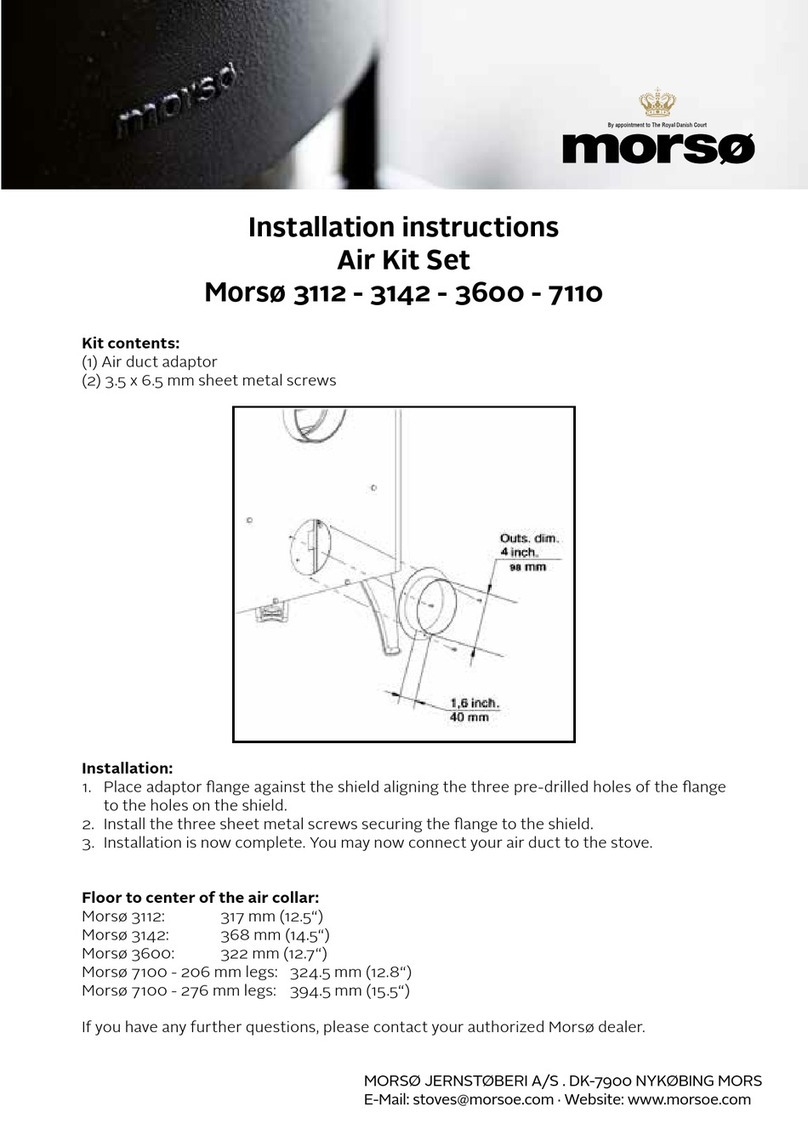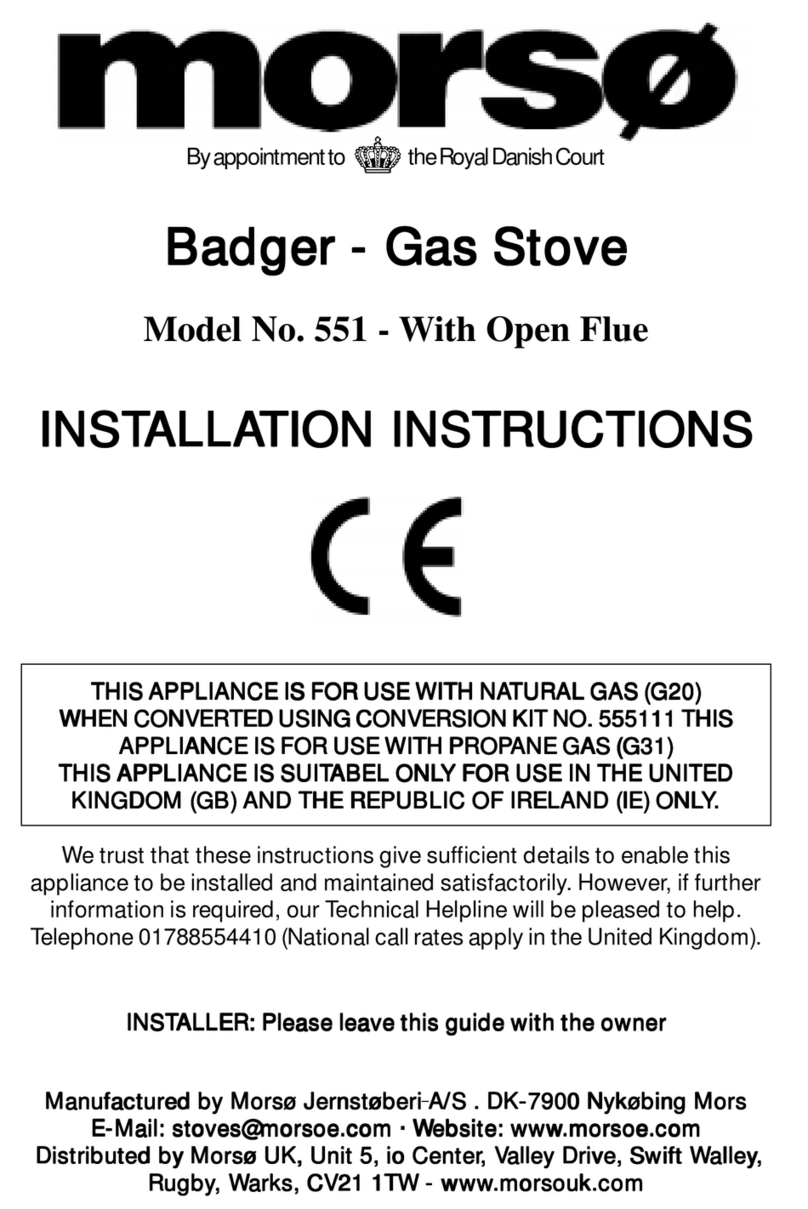1.9 Draught
If smoke comes out of the stove when the fire door is opened, it will be due to the poor draught
in the chimney. This type of stove requires at least 12 pa. of chimney draught to achieve satis-
factory combustion, and to prevent smoke from escaping. Smoke may, however, escape in any
event, if the stove door is opened during very vigorous burning, so this should be avoided.
The flue gas temperature at the rated output is 184°C relative to 20°C.
If in doubt, you may want to get your chimney sweep to measure the draught in the chimney.
Draught
The draught in the chimney is the result of the difference between the high tempera-
ture in the chimney and the cooler temperature outside. Other factors that determine
whether enough negative pressure can be produced to create a draught include the
length and insulation of the chimney, and wind and weather conditions.
The draught will be reduced when:
- The temperature difference is too low, e.g. in connection with a poorly insulated chim-
ney. If the chimney is cold, it may help to light (burn up) a rolled-up newspaper in the
chimney’s cleaning door.
- The outside temperature is too high, for example during the summer.
- There is no wind.
- The chimney is not tall enough, with the result that it sits in the lee of the roof sur-
face or tall trees. These conditions are also associated with the greatest risk of smo-
ke coming back down the chimney.
- Air is entering the chimney in undesired places, e.g. through cracked joints or leaks
in the cleaning door or the flue pipe.
- Unsealed, unused fireplaces are connected to the chimney.
- The flue pipe and chimney are clogged up with soot, due to inadequate cleaning.
- The house is too tightly sealed (please see the section on Fresh air supply).
- Too little air is getting in.
A good draught is achieved when:
- There is a big difference between the temperature in the chimney and outside duri-
ng firing, i.e. when the need for heating is greatest.
- The weather is clear and there is a good wind.
- The chimney is of the proper height, i.e. at least 4 metres above the stove, and clear
of the spine of the roof.
N.B!
Wood is a material that contains a great deal of gas (approximately 75 %). The gases are
released when the wood is lit and heated up. For this reason, it is important that the gases
are ignited quickly after stoking. If the wood just lies smouldering, especially after re-sto-
king, a lot of smoke is created, which, in the worst case, may cause an explosive ignition of
the gasses, resulting in damage to the stove.
In order to ignite the gases that are released from the wood, and to keep clear, lasting
flames during the combustion process, it is important to let in the required quantity of
oxygen (air supply) at all times. The setting of the air supply, the method of ignition and
the lighting intervals depend on the draught in the chimney, the wind and weather, the
amount of heat required, the fuel, etc. This means that it may take some time before you
get to know the correct functioning of the stove under any given circumstances.
Although you can fire your Morsø stove with almost all kinds of wood, you should not fire
with wet wood, or unseasoned wood. Wood ought to be stored under a roof for at least 1
year, and preferably 2 years, with free access to wind. Wood should be chopped as soon as
possible after felling if it is to dry quickly. The wood can be used once the moisture content
is less than 20%. During the EN test, all stoves are tested with wood with a moisture con-
tent of (16 ± 4)%.
Never use driftwood, as it usually has a high salt content, which damages both the stove
and the chimney. Impregnated and painted wood and chipboard emit poisonous smoke
and fumes, so they should not be used as fuel either.
Please note that liquid fuel may not be used in the stove.
Pieces of wood with a diameter greater than 10 cm should always be chopped.
The pieces of wood should be short enough to be able to lie flat over the layer of embers,
with air at both ends.
The maximum length of fuel in the stove is 30 cm.
The maximum quantity of fuel is 2 kg/hour (max. 2 pieces of wood each time you re-stoke).
The first few times you light the stove, the fire should be moderate, so that the heat-re-
sistant paint can harden before firing more vigorously. During the hardening phase, the
paint may develop obnoxious smoke and smell the first time it is lit, which is very normal.
Make sure that the room is well ventilated during this period.
When heating up or cooling down, the material is exposed to major temperature diffe-
rences that may cause the stove to give off creaking sounds.
2.0 Firing/using the stove
Your stove is constructed with air inlets in three places.
Pre-heated, fast-moving combustion air is added to the fire beneath the grate. and is regulat-
ed using the handle beneath the door. The combustion air is let in when the handle is pushed
to the left, and shut off when the handle is pushed to the middle position. This kind of combus-
tion air is only to be used during start-up and only when conditions are bad. Bad conditions
could be insufficient flue draft or wood with high humidity.
Pre-heated, fast-moving combustion air is added to the fire above the glass window, and is
regulated using the handle beneath the door. The combustion air is let in when the handle is
pushed to the right, and shut off when the handle is pushed to the middle position.
Another air inlet provides a constant, pre-heated air supply which cannot be adjusted, and
which comes into the combustion chamber just above the fire. This helps to burn off the last
few gasses emitted by the wood whilst it is being heated up.


















































